Embracing Belfast’s Riverfront as Public Space
edited by Dr Nuala Flood




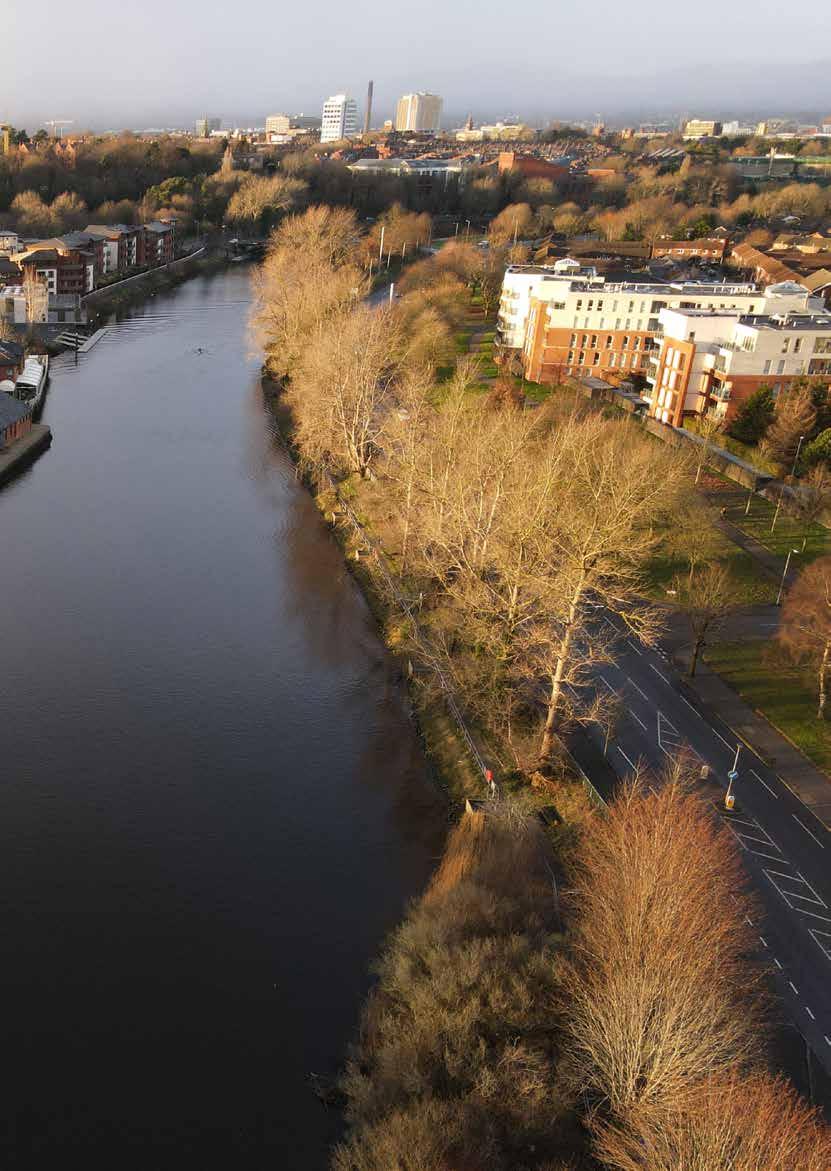


I would like to thank the following architecture students from Queen’s University Belfast (QUB) who participated wholeheartedly and creatively in Public CoLab 2023: Daisy Adams, Dhanish Ahmed, Evonne Alexander, Maram Alissa, Gabriella Amanda, Max Anderson, Natalie Anderson, Ian Bagasala, Molly Baker, Jordan Barrow, Megan Batty, Aditi A.Benke, Magdalena Bepierszcz, Daniel Bittles, Ioanna Boumpalou, Matthew Brown, Maria Elena Cariaga, Rebecca Carrothers, Shreya Chhajer, Sharon Chungath, Siobhán Coakley, Piers Collins, Maria Commons, Leo Conway, Sophia Costa Kloeckner, Katelyn Cumiskey, Grace Davis, Ella Doherty, Niamh Donnelly, Jessica Jayne Dorrian, Ashvin Elango, Mariah Faherty, Emma Fitzpatrick, Zoe Fleming, Lauren Forte, Oileán Galligan, Michaela Galvin, Jessica Garrett, Shivani A. Gite, Lucy Glass, Vanusa Gomes Te, Nadine Graham-Mulgrew, Aimee Grant, Naomi Gray, Olivia Greensmith, Darragh Hamilton, Alex Howard Smith, Emily Ireland, Hannah Jackson, Yedam Jeon, Yangtao Jiang, Emilie Jones, Alex Judd, Rishi Kamble, Emma Kane, Denise Keaney, Philip Kennedy, Leng Ket Yang, Philippa Koh, Natal Koulaylat, Peter Lawson, Jake Lebel, Edward Lee, Hok Chi Leung, Annabeth Tzong Lim, Samuel Chin Wei Lo, Megan Lowry, Saud Makki, Maya Marron, Sasha Martin, Eleanor Mc Quaid, Aoife McAvoy, Kerry McCabe, Rory McCormack, Reece McGeoghegan, Fiona McGrath, Ellen McKeag, Suman Miah, Geethu Mohandas, Natalia Mokras, Lucy Monteith, Deedhiti Mukherjee, Faye Murphy, Micheal Murphy, Rachel Murphy, Syed M. Naqvi, Jack Nolan, Molly O’Beirne, Erin O’Connor, Aoife O’Neill, Ciara Page, Alex Peacock, Oliver Petch, Alice Poole, Ethan Potter, D. Kaarthick Ravichandran, Ashish K. Salimon, William Luca Santoso, Lin Shan Ying, Anna Shaw, Iznay Shuja, Shuyu Si, Trinity Stevenson, Caitlin Suribas, Nicole Thompson, Scott Wilson, Low Chuan Yin Amelia, Min-Hui Yu and Zhouzi Zhou.
I would also like to thank all of the following project collaborators for giving so generously of their time to help shape the project and for their thoughtful presentations that catalysed the students design processes: Dr Callie Persic (Belfast City Council), Dr Mura Quigley (Belfast City Council), Dr Jane McCullough (Climate NI), Dr Andy Bridge (Lagan Valley Regional Park), Judith Webb (Maritime Belfast), Dr Colin Shaw (Save Our Lagan), Prof. Mark Emmerson and Prof. Sue-Ann Harding (Queen’s University), and Caoimhe O’Neill and Liam Mularkey (Department for Infrastructure).
The framing of Public CoLab 2023 was developed as part of a UK Economic and Social Research Council Impact Acceleration Award. I am very thankful to ESRC and Queen’s University for this support that enabled me to explore potential synergies between architectural education at Queen’s, the ambitions of the city regeneration team at Belfast City Council and the timely work of Climate Northern Ireland. In particular, I would like to thank Dr. Callie Persic and Dr. Jane McCullough for their generous engagement with this collaboration and Alice Neelson for her expert guidance through this award application process. The brief for Public CoLab 2023 was further developed and consolidated while I was a Fulbright Scholar at Urban Systems Lab, the New School, New York, researching the design of public space with respect to future climates, sea level rise and a shifting hydroscape. I am very grateful to Fulbright Eire, the Environmental Protection Agency (Ireland) and Queen’s University for supporting this research and, also, to Urban Systems Lab for hosting this scholarship.
Dr. Nuala Flood, Belfast 2023






Public CoLab is an annual collaborative design research laboratory at Queen’s University Belfast. It provides a platform for teams of architecture students to work with external partners to develop an expanded understanding of the spatial manifestations of globally contentious issues within the context of public space in Belfast and beyond. Each team utilises their skills, creativity, and ingenuity to create visualizations, design proposals, design scenarios and spatial narratives that seek to improve socio-environmental issues in public spaces. Public CoLab provides a platform for the architecture students, as informed citizens, to make valuable contributions towards the formation of public life and the design of public spaces in their homeplace.
Public CoLab 2023 challenged the students to design public spaces, along the banks of the River Lagan, to address both the climate and biodiversity crisis. The overarching goal was to create visions of a netzero carbon Belfast that describe a future that is not only possible, but also highly desirable. These visions build upon the ambitions presented in the Bolder Vision for Belfast and the Net-Zero Carbon Roadmap for Belfast.
The Public CoLab research methodology is akin to five-day design sprint; it is fast-paced, action-focused and project-orientated. The project is catalysed by a series of contextualising lectures by the external partners. The design process incorporates site visits, precedent exploration, critiques of the existing landscape and the iterative design of spatial interventions. Each research team has post-graduate MArch 1 students and stage 1 undergraduate architecture students. Together, the teams examined one of eleven discrete sections of the River Lagan and mapped it from various perspectives, including their own as a student/citizen, that of a prescribed marginalised user and a range of resident animals, birds and fish. Based on these observations, they created urban design interventions that sought to challenge how we might create public space along the Lagan, and adjacent to the tidal flood alleviation scheme, to allow both humans and non-human life to flourish.
Throughout the project, the teams work together in the shared space of the design studio and in conversation with tutors, external collaborators, and the larger cohort. This working arrangement allowed for the cross pollination of ideas and for the cohort to learn through observing each of the eleven projects coevolve. Therefore, the projects are seen to be collectively produced by all participants. A selection of the project outputs are published here under a creative commons licence. If you are interested in improving public space along the Lagan in Belfast, you are invited to reference and build upon the students’ imaginative design propositions that follow.

...AREA 1 for seagulls and cyclists?
...AREA 2 for butterflys and people with limited mobility?
...AREA 3 for dog-walkers and linnets?
...AREA 4 for kyakers and pike?
...AREA 5 for swimmers and seals?
...AREA 6 for runners and brown trout?
...AREA 7 for bats and people with mild nyctophobia?
...AREA 8 for wildlife photographers and red squirrels?
...AREA 9 for guerrilla gardeners and bees?
...AREA 10 for rowers and herron?
...AREA 11 for nine-year-old children and hedgehogs?
This project proposes several urban design interventions including lush green spaces, improved cycling infrastructure, two new bridges, local shops, a café overlooking the harbour and floating islands to support biodiversity and resident seagulls.








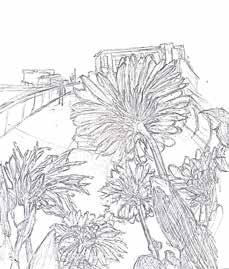

Can a strategic combination of urban design interventions including parks, aquaponics and accessible planting improve public space along the riverfront for people with limited mobility and for biodiversity?


This proposal includes a new timber pedestrian bridge, covered in greenery, on an axis leading toward the cranes of Harland and Wolfe, and a new path, aimed at dog walkers and pedestrians, with sections on stilts, tapering around the given site, in loops. The quay wall has been replaced with stairs and a more natural slope, with plants along it to absorb water. It has a raised hill on the north bank that inclines back from the river, relieveing water pressure, and providing walkers with a view over the city. Further north of the bank, a forested area without paths will be a quiet place for local nature, including linnets, to thrive, and bird watching area will be made to allow people to observe the local fauna without disturbing them. The entire waste area will be a dense forest, and the quays on both sides of the bridge will be lined with trees. The area will be retrofitted with new bins, streetlights, and provisions for dog walkers, which turning this once empty quarter of the city into a much-needed park, right outside the city centre.





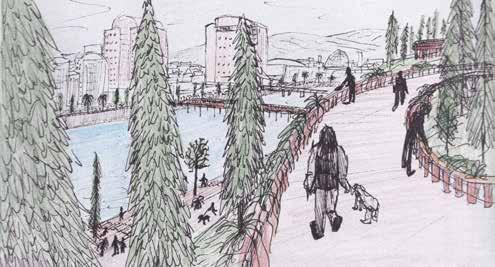
This design proposal includes the creation of a series of floating islands covered in vegetation on the river, the conversion of the existing marina into a dock, changing rooms and a storage area for kayakers made from recycled shipping containers, and the installation of an underwater aeration system. The floating islands will introduce plants and greenery to an area of the river that does not otherwise have it. As well as providing much needed habitats for biodiversity, these floating planters will also benefit kayakers providing a scenic route as they paddle around these islands, breaking up the repetition of kayaking. The proposed dock will allow kayakers to get in and out of the water with ease. The marina would also provide a safe space for beginners to get used to being in the water.

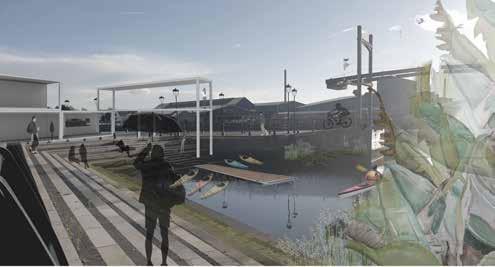



This proposal regenerates the disused carparking spaces of Ravenhill Reach into a community hub. The tarmac will be replaced with permeable clay brick pavers to help absorb the excess surface water. A new glass floodwall will also be incorporated. Planting along the riverfront including willow, oak, ask and alder will help alleviate the flooding. New seating with planters will be introduced keeping the central space clear for clubs linked with the Ormeau Ozone. Spaces will be provided for mobile coffee and food kiosks. At the water level a timber floating pool, which rises and falls with the tides is proposed. The proposal also includes spaces for changing and a range of different types of pools including a natural planted splash pool, a shallow leisure pool and a larger deeper pool for training. The pools will contain filtered water from the Lagan. The floating pools are protected by planters and glass balustrades, making it feel like you are swimming around a natural space, while simultaneously controlling access. The banks of the river opposite the swimming pool are replanted and extended to provide a resting place for seals and a rich habitat for biodiversity.

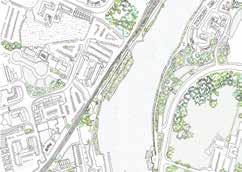




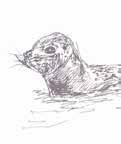



This design proposes floating promenade and dense vegetation on the banks of the river to accommodate and alleviate future flooding, while also providing a rich habitat for biodiversity. Terraced steps lead down to a shallow and accessible part of the river. The pedestrian and running track is interspersed with pit-stops inclusive of water fountains, benches and bins.



This proposal provides stations along the riverfront where dual function mobile lanterns/umbrellas can be temporarily hired, a bit like Belfast bikes, to light the way on walks after dark.










Extensive planting of native woodland along the riverfront to provides a habitat for wildlife including red squirrels. A range of context sensitive timber huts are dispersed amongst the trees providing a refuge for wildlife photographers to capture images and observe the surrounding landscape.



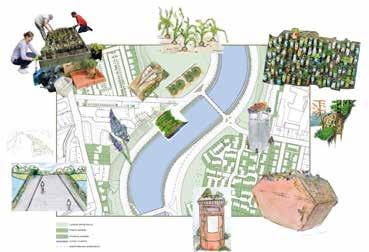







This proposal includes the strategic placement of bee bricks, beehives, wildflower planting and allotments along the existing cycle paths to provide a rich habitat for a wide variety of native bees and an enriched environment in which to cycle through.

This proposal focuses on a specific section of the Lagan River between Lockview Road and the Annadale Embankment. It proposes a series of urban interventions that intend to activate the rewilding of this area of the riverfront, post the extensive tree felling that was undertaken as part of the tidal flood alleviation scheme. The design includes an esplanade running adjacent to the periphery of the western riverbank, supported on stilts, with the ability to rise upwards in the event of a flood. Pontoons are also integrated, which can submerge underwater to simplify the beginning of canal journeys. A bridge is also proposed on the southern end of our design to create circular access, while featuring upper and lower canopies for herons to roost on. For further development in the foreseeable future, modern extensions to the existing boat houses may be made to increase space for mixed-use. To improve biodiversity, a mussel farm, both above and below the water level, is proposed. The mussels will clean the water of the river by consuming any waste. They will also attract fish, which will in turn attract herons. Furthermore, multiple reedbed nurseries will be located alongside the esplanade – this is essential for increasing the heron population as reeds are used by herons to build nests.

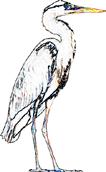








This proposal creates a space that allows children to connect with nature and safely gain independence. The main intervention is a partially complete geodesic dome structure that forms a ‘Forest school’. The project includes a new path that connects the local primary school to the forest school through a community garden which provides a safe route for children away from main roads. The concept is to provide both a sheltered classroom space and hedgehog sanctuary simultaneously. Through the seating design the hedgehogs can burrow into the depth of the seating protected from the children roaming above - this line then becomes blurred with viewing boxes perforating the seating to allow some interaction between the two species. Given the temporal practices of 9-year-old humans and hedgehogs, this structure will be occupied by both at different times throughout the day. Hedgehogs being nocturnal animals inhabit the structure through the night and then vacate or sleep during the day, freeing the space up for children to roam after school or as an outing as part of their curriculum.






Daisy Adams, Dhanish Ahmed, Evonne Alexander, Maram Alissa, Gabriella Amanda, Max Anderson, Natalie Anderson, Ian Bagasala, Molly Baker, Jordan Barrow, Megan Batty, Aditi A.Benke, Magdalena Bepierszcz, Daniel Bittles, Ioanna Boumpalou, Andy Bridge, Matthew Brown, Maria Elena Cariaga, Rebecca Carrothers, Shreya Chhajer, Sharon Chungath, Siobhán Coakley, Piers Collins, Maria Commons, Leo Conway, Sophia Costa Kloeckner, Jane McCullough, Katelyn Cumiskey, Grace Davis, Ella Doherty, Niamh Donnelly, Jessica Jayne Dorrian, Ashvin Elango, Mark Emmerson, Mariah
Faherty, Emma Fitzpatrick, Zoe Fleming, Lauren Forte, Oileán Galligan, Michaela Galvin, Jessica Garrett, Shivani A. Gite, Lucy Glass, Vanusa Gomes Te, Nadine Graham-Mulgrew, Aimee Grant, Naomi Gray, Olivia Greensmith, Darragh Hamilton, Sue-Ann Harding, Alex Howard Smith, Emily Ireland, Hannah Jackson, Yedam Jeon, Yangtao Jiang, Emilie Jones, Alex Judd, Rishi Kamble, Emma Kane, Denise Keaney, Philip Kennedy, Leng Ket Yang, Philippa Koh, Natal Koulaylat, Peter Lawson, Jake Lebel, Edward Lee, Hok Chi Leung, Annabeth Tzong Lim, Samuel Chin Wei Lo, Megan Lowry, Saud Makki, Maya Marron, Sasha Martin, Eleanor Mc Quaid, Aoife McAvoy, Kerry McCabe, Rory McCormack, Reece McGeoghegan, Fiona McGrath, Ellen McKeag, Suman Miah, Geethu Mohandas, Natalia Mokras, Lucy Monteith, Deedhiti Mukherjee, Liam Mularkey, Faye Murphy, Micheal Murphy, Rachel Murphy, Syed M. Naqvi, Chantelle Niblock, Jack Nolan, Molly O’Beirne, Erin O’Connor, Aoife O’Neill, Caoimhe O’Neill, Ciara Page, Alex Peacock, Callie Persic, Oliver Petch, Alice Poole, Ethan Potter, Mura Quigley, Kaarthick Ravichandran, Ashish K. Salimon, Colin Shaw, William Luca Santoso, Lin Shan Ying, Anna Shaw, Iznay Shuja, Shuyu Si, Trinity Stevenson, Caitlin Suribas, Nicole Thompson, Petrina Tierney, Judith Webb, Scott Wilson, Low Chuan Yin Amelia, Min-Hui Yu and Zhouzi Zhou.